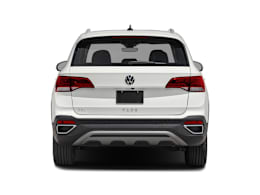The Taos is the latest model in Volkswagen’s expanding SUV portfolio, slotting below the Tiguan in size and price. While it has a surprisingly roomy cabin for such a small vehicle, along with fairly nimble handling, its powertrain has serious hiccups that literally give us pause. We’re also disappointed that forward collision warning, automatic emergency braking with pedestrian detection, blind spot warning, and rear cross traffic warning are not standard—they’re optional on the base S, though standard on the other trims.
It’s the SUV’s obstreperous powertrain that would keep us from buying it more than anything, though—especially the all-wheel-drive model (which VW refers to as “4Motion”) with its seven-speed dual-clutch automatic transmission. The Taos suffers from a big initial delay when trying to accelerate from a stop, followed by an abrupt burst of power as it gets going. This can make you feel vulnerable, for instance, if you need to accelerate out onto a busy road. These traits make the Taos difficult to drive smoothly, and caused one CR driver to call the powertrain “manic,” and another said she couldn’t wait to bring the Taos back to the office.
Once the Taos gets underway, however, its transmission shifts smoothly, and the 158-horsepower, 1.5-liter turbocharged four-cylinder has a meaty midrange punch. The 9.4 seconds it took for our SE AWD to run from 0 to 60 mph makes the Taos one of the quicker SUVs in what is a pretty tepid-accelerating class. Its fuel economy of 26 mpg overall in our testing is reasonably decent for a small all-wheel-drive SUV, but it lags a few mpg behind the Subaru Crosstrek, a direct competitor.
Front-wheel-drive models come with a conventional eight-speed automatic transmission that has far less of a delay off the line, though the engine’s power can still burst forth unexpectedly at times.
On the plus side, its compact dimensions, responsive steering, and taut suspension help the Taos take turns tightly. We found the steering feels overly light in its Normal drive setting, but it firms up when switched to Sport mode, which improves driver confidence. The Taos proved a willing partner when taken to its limits around our test track, carving through corners with good precision, although its speed through our avoidance maneuver—which simulates swerving quickly to avoid a vehicle or obstacle on the road—was a bit slower than most rivals because the electronic stability control (ESC) system kicks in aggressively to keep the vehicle in control. Ride comfort is quite firm though civilized, and as such we highly recommend sticking with 18-inch tires vs. the 19-inch versions that come on the top SEL trim. The 18s keep the truly harsh road imperfections out of the cabin, but the Taos is no match for the absorbent ride of the Subaru Crosstrek.
The front seats are comfortable and supportive with generous side bolsters to help hold occupants in place through corners, and we appreciate the ability to tilt the bottom cushion’s front edge up and down. There’s tons of headroom, and the driver benefits from a nicely placed left footrest, but the plastic center console proved a constant right-knee intrusion, and some of our drivers were annoyed that the center armrest sits on a lower plane than the one on the door. Although the Taos is considerably shorter than the Tiguan, the rear seat is almost shockingly spacious, with lots of knee room and really good foot space under the front seats. The contouring of the seats aids support and comfort. There’s less cargo space than in the larger Tiguan, but the Taos’ square shape makes what is there pretty useful. That vehicle’s shape and upright stance also contribute to excellent outward visibility.
The eight-inch center infotainment display is within good reach of the driver and is generally easy to see and use. But some of the Taos’ other controls aren’t as intuitive as we typically see from VW. For instance, what looks like an audio tuning knob doesn’t function like one, and it isn’t clear how to switch back and forth between Android Auto/Apple CarPlay and VW’s built-in infotainment system. Capacitive-touch shortcut “buttons” flank the display screen, but without any tactile feedback they are difficult to use without taking your eyes off the road.
We liked our test model’s two-tone seats and blue trim throughout, but the cabin doesn’t match its $33,000 price. There are too many plastic pieces that have a cheap and hollow feel. Still, several upscale amenities are available, such as a digital instrument cluster, heated and ventilated front seats, and a panoramic sunroof.
Important active safety systems such as forward collision warning, automatic emergency braking with pedestrian detection, blind spot warning, and rear cross traffic warning don’t come standard on the base Taos model. All of these systems come standard on the other trims, though.


























